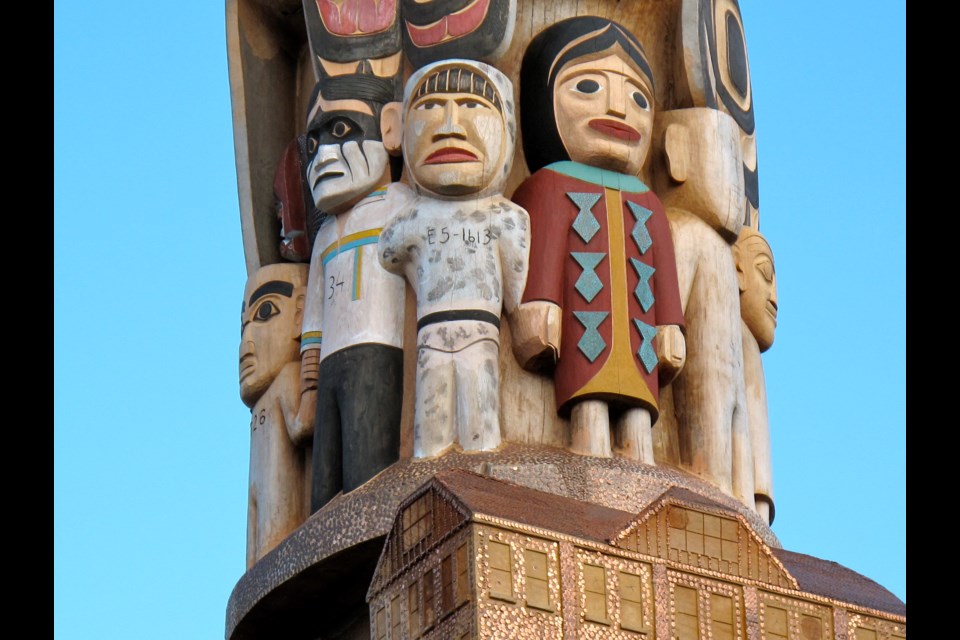Barney Williams woke before sunrise Saturday to ensure he and his wife, Trina, would have enough time to drive from their home near Parksville to catch the early ferry to the mainland.
He put on black pants, a black shirt and a long black leather jacket. He then packed his walker into the car. At 77, the member of the Tlaoquiaht First Nation has problems with his spine and knows it's only a matter of time when he'll be in a wheelchair.
"That's just another challenge for me," he said a few days before his trip to Vancouver, where he would speak to more than 3,000 people at the University of B.C. about his experience at two Indian residential schools. "I've had a lot of challenges, so this is just another one. I've accepted that, as well."
When he got to the main mall on campus, he and Trina took their seats a few rows from a stage where Haida master carver and hereditary chief James Hart would be celebrated for a totem pole he and his apprentices carved as a tribute to residential school survivors and those who died during and after the dark period in Canada's history.
Before the ceremony began, Williams shared that he had mixed emotions about the day. He learned shortly after he woke Saturday that his good friend, Ray Martin, died. He was 69, also a residential school survivor.
"That was unexpected," he said, noting they had lunch together a few days ago. "He would have wanted me to be here, though. And I'm feeling the energy here today. It's not low energy, it's very high. It's a good feeling."
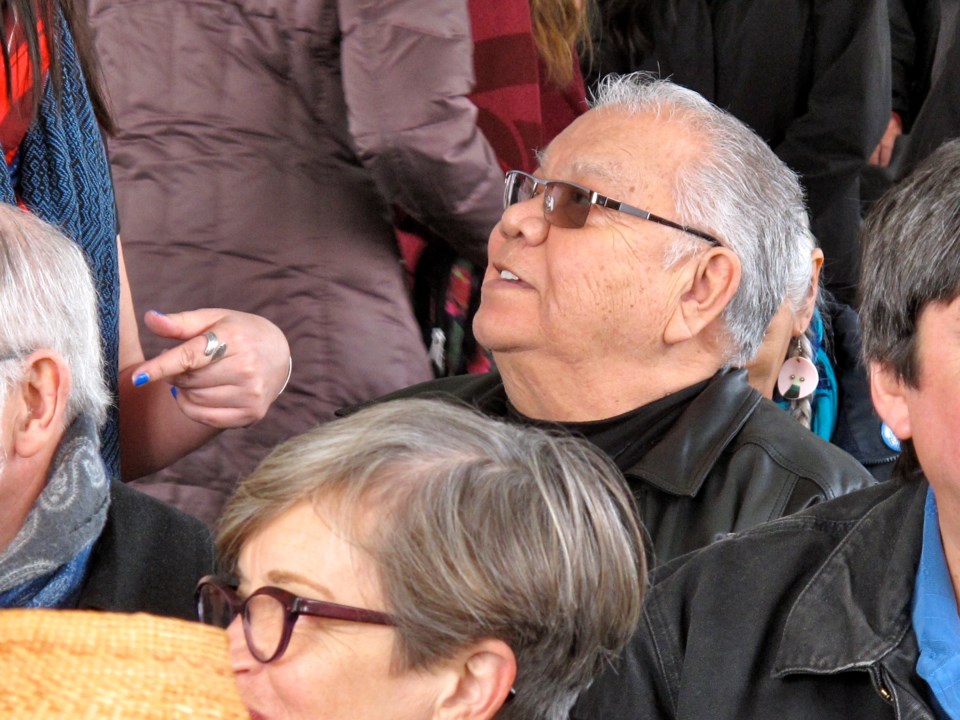
Williams would talk more about his old friend when it came time for him to speak. But he would first listen to more than an hour of emotional and moving speeches from a long list of people that included leaders of the Haida and Musqueam nations, UBC president Santa Ono and Hart, whose two-year-long project was about to come to an end with the raising of the "reconciliation pole."
"It's not about me, it's about all of us," Hart said of the 55-foot pole that was carved from an 800-year-old red cedar cut down in Haida Gwaii and transported by barge and truck to its final resting spot on the main mall.
Commissioned by the Audain Foundation and UBC, Hart designed the pole to depict what life was like for Aboriginal peoples before and after the residential school system, which began in the 1840s and ended in 1996. The Truth and Reconciliation Commission of Canada estimated more than 6,000 children died at residential schools, although other estimates in indigenous communities suggest thousands more perished. Some 150,000 children from across Canada attended the church-run, government-funded schools, which were designed to have indigenous children assimilate into mainstream Canadian society.
The centrepiece of Hart's pole is a haunting looking residential school modeled after the Coqualeetza school in Sardis, B.C., where Hart's grandfather and other relatives attended as children. Hart, whose indigenous name is anglicized to Edenshaw, never went to residential school. The intricately carved school is covered in thousands of copper nails, which were hammered in by residential school survivors, affected families, school children and others. The nails represent the children who died in the schools.
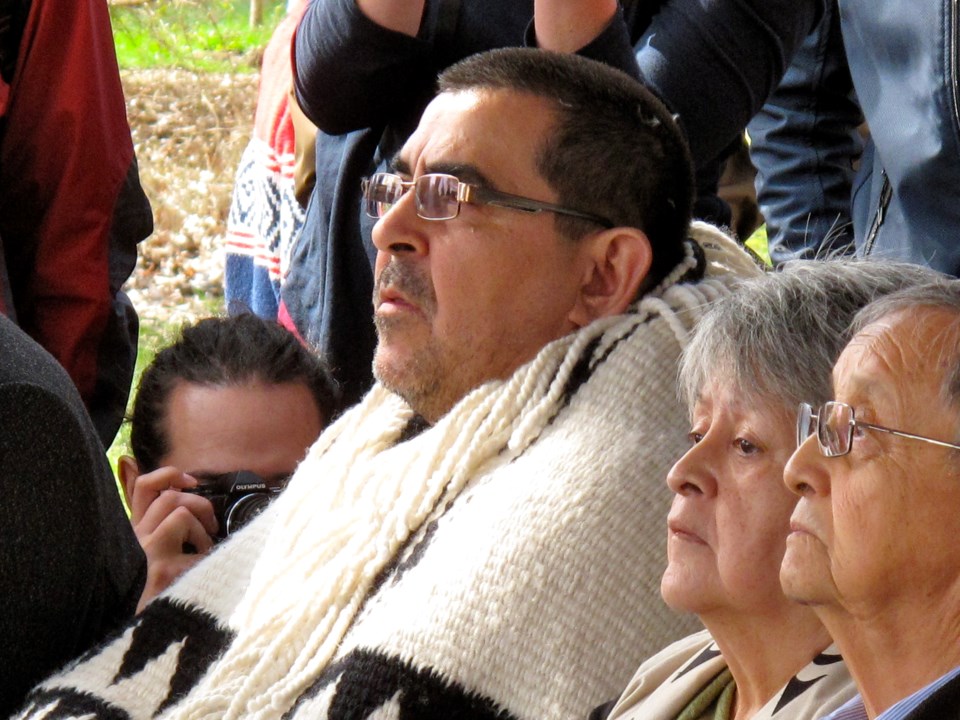
Musqueam elder Larry Grant said losing children to those schools shattered families. He told the crowd that totems like Hart's should be standing in every city and community where there were residential schools.
"So that we never, never, never see the holocaust of our children again," said Grant, whose nation allowed Hart's pole to be raised on the band's traditional homelands.
Darin Swanson, one of the Haida's hereditary chiefs, told a story about how his eldest sister, Yvonne, was seven years old when government officials "literally kidnapped her" from a relative's backyard.
"They tricked her, they brought her to a ship, they fed her cantaloupe and ice cream," he said, before telling a story about his brother, Freddie, who was 14 when he was transported to residential schools in Edmonton, Alert Bay and North Vancouver. He ran away from all of the schools.
"They couldn't contain him, so they put him in jail at the age of 14," he said, noting he wasn't released until he was 18. That experience sent Freddie in a downward spiral and he died in the Downtown Eastside in 1997.
Swanson's words were soon followed by a speech by the university's president, who urged people to be inspired by the totem and that it be an example of true reconciliation for the world.
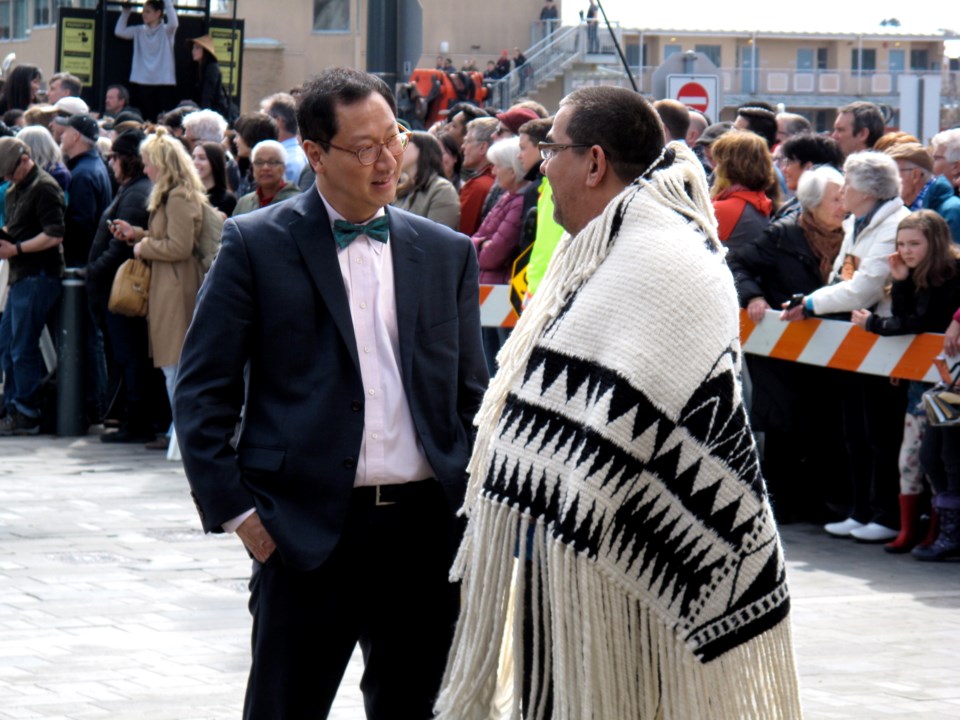
Ono noted how the pole will face the university's Indian Residential School History and Dialogue Centre, where stories of survivors and records gathered by the Truth and Reconciliation Commission will be accessible to the public. The centre is under construction and expected to open within two years.
"Together, they will provide a landmark and a place to better understand the history and lasting effects of Canada's Indian residential schools," he said. "We cannot change the past, but we honestly must work diligently and sincerely to recognize the past."
When it came time for Williams to speak, thousands of people had gathered in and outside the large tent set up for the ceremony. He got up from his chair, his wife following closely behind for a few steps to ensure he didn't fall before getting to the stage. He didn't bother with his walker.
'A Canadian problem'
He opened in his native language, motioning to the front row of guests, including Musqueam Chief Wayne Sparrow, Hart and his wife, Rosemary. Then for 14 minutes, he told his story about being raped, beaten and starved in residential schools near his home village on Meares Island and in Kamloops, where he attended high school. For 13 years, he was told he was "too dumb to be a human."
"This is real, folks, this is not something that we make up because we want sympathy," he said. "We tell you these stories because they happened. We tell you these stories because this is the history that Canada has. We're also here to tell you that it's a Canadian problem, it's not just a First Nations problem. This problem belongs to everybody."
He said he had pain in his heart as he stood on stage, informing the crowd of the sudden death of his friend, Ray Martin. He repeated what he told the Courier earlier in the day.
"He would have said to me, partner, go — go and tell them, remind them what's been alluded to here today and tell them that we need to come together," he said, before turning his attention to the totem. "I stand here with much pride to see something that's spiritual, something that means more than just a symbol. It reminds me of the strength and the resilience that all the children had throughout those years."
Williams was locked in a cubicle for 18 hours when he was a child and had been afraid to turn off the light in his bedroom until only two years ago. For the longest time, when he heard footsteps in his hallway, he thought someone was coming for him.
"Then I realized that I'm OK, that nobody's coming for me — that I'm in a different place and a different time," said Williams, who battled alcoholism for many years before getting sober and obtaining a degree in social work, which led him to work in treatment centres. He worked for Health Canada and Indian and Northern Affairs. More recently, he was a member of the elders' circle tied to the Truth and Reconciliation Commission of Canada.
Near the end of his speech, Williams talked about how important his wife and family are to him, and that it's only been recently that he's learned to tell the people closest to him how much he loves them.
"I've only learned in the last little while how to express it — to be able to say I love you, to be able to embrace them, give them a hug," he said. "I have no shame in crying now. I have no shame in showing emotion. I have no shame in saying to someone that I don't understand, you have to help me."
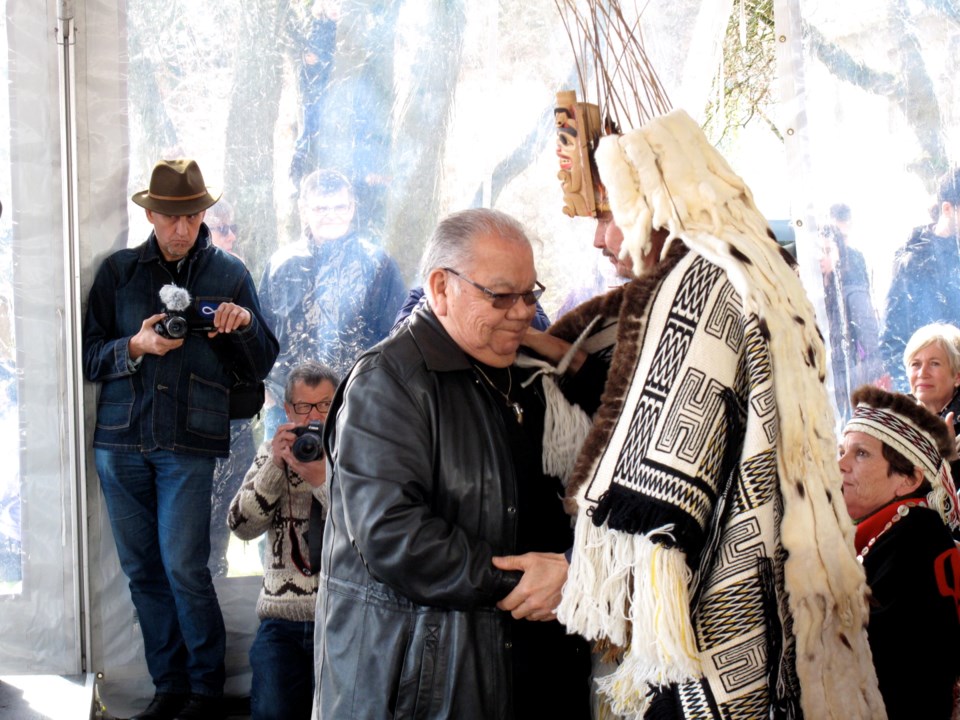
As he left the stage, he stopped in front of Hart, who stood and embraced him. The two men had not met until that moment. A few more residential school survivors, including Sophina Jones and Russell Davis, followed with similar stories. Adina Williams, a second-year student at UBC from the Squamish nation, was the last speaker of the afternoon. She addressed the residential school survivors.
"As a young Aboriginal person, I know how much your strength and resilience has impacted young people like me," said Williams, who is not related to Barney. "Because my parents, who are survivors, have used that strength and resilience to help me become the proud Squamish and Namgis person I am today."
She told the crowd she was the first person in her family to not be directly affected by assimilation forced on Aboriginal peoples by the Canadian government.
"I am so grateful that both my parents eventually, on their own, found their way home," she said. "But much like the children who stand on the reconciliation pole with no feet — the children who came out of those schools without any grounding — my parents, too, returned home without a solid grounding in their communities."
Added Williams: "Before I left the house this morning, my parents reminded me that just me standing here today, and being able to speak to you and share how I think we can move forward together towards a reconciled future — that is an opportunity that my parents did not have. It is gatherings like these that leave me very hopeful for a future for my children, grandchildren and great grandchildren."
Applause followed before the crowd got in place to help raise the pole.
Drumming and singing began as dozens of First Nations leaders and their families participated in a ceremony where they threw stones from Haida Gwaii into a deep pit that was dug to hold the pole. Four long ropes tied to the 26,000-pound totem ran across the mall and into a field where hundreds of people waited instructions to raise the pole.
Under the guidance of engineering crews, the pole was slowly pulled into the pit until it was set upright in place, sending up cheers all over the mall as the eagle on top lit up in the sunshine.
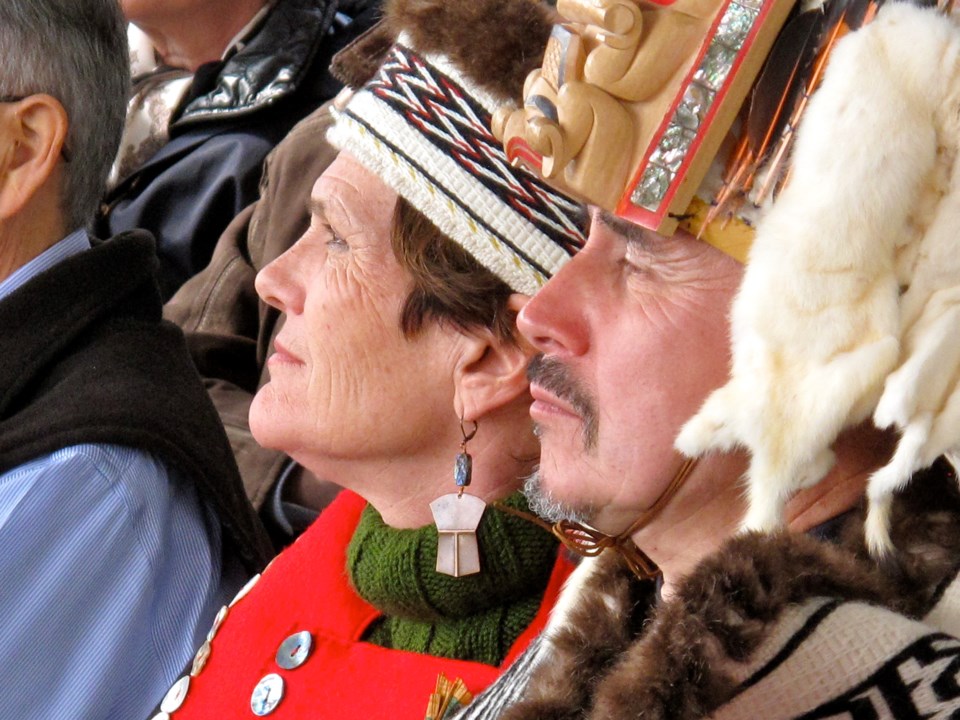
Standing back to take it all in was Hart, who after what had been an emotional project — both for the subject matter and working through the sudden death of one of his sons, Carl, who helped carve the eagle and the boats — was admittedly exhausted but happy.
But, as he said again, the totem and what it represents was not about him, but about the survivors like Barney Williams and Sophina Jones and Russell Davis, the deceased children and the need to educate all Canadians about a history that ruined so many lives.
"That's what it's about, and having people like [Barney] speak about those times because that really happened — like he said, it was for real. People still don't want to believe that. They have a hard time believing that happened here in Canada. The whole thing was an evil plan, but we're here today and we want to move forward."
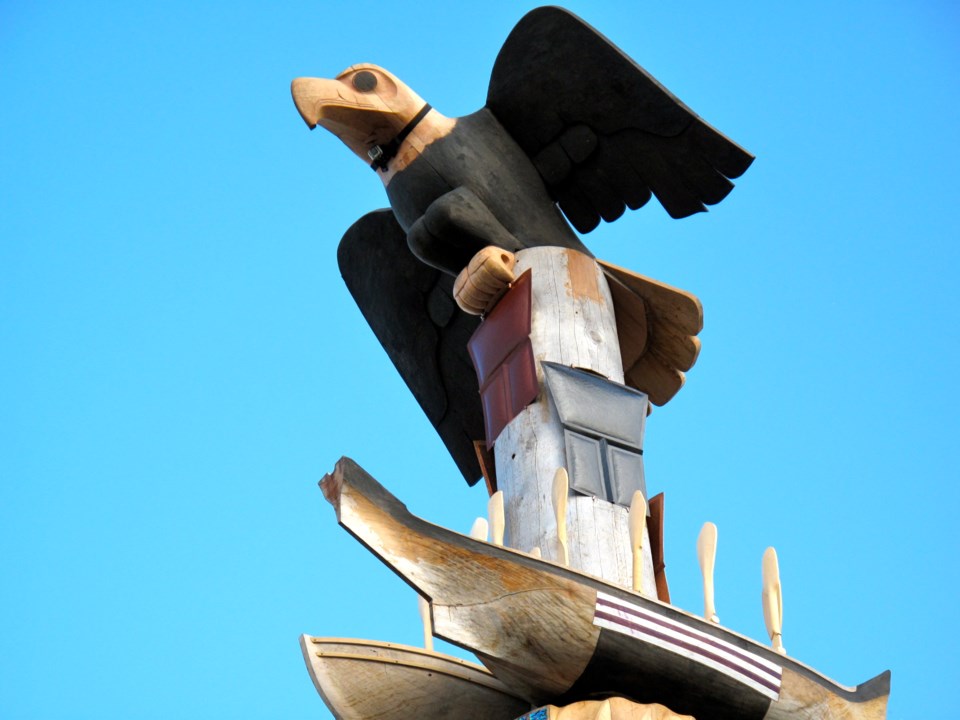
@Howellings
